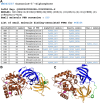Leveraging AI to explore structural contexts of post-translational modifications in drug binding
- PMID: 40320551
- PMCID: PMC12051291
- DOI: 10.1186/s13321-025-01019-y
Leveraging AI to explore structural contexts of post-translational modifications in drug binding
Abstract
Post-translational modifications (PTMs) play a crucial role in allowing cells to expand the functionality of their proteins and adaptively regulate their signaling pathways. Defects in PTMs have been linked to numerous developmental disorders and human diseases, including cancer, diabetes, heart, neurodegenerative and metabolic diseases. PTMs are important targets in drug discovery, as they can significantly influence various aspects of drug interactions including binding affinity. The structural consequences of PTMs, such as phosphorylation-induced conformational changes or their effects on ligand binding affinity, have historically been challenging to study on a large scale, primarily due to reliance on experimental methods. Recent advancements in computational power and artificial intelligence, particularly in deep learning algorithms and protein structure prediction tools like AlphaFold3, have opened new possibilities for exploring the structural context of interactions between PTMs and drugs. These AI-driven methods enable accurate modeling of protein structures including prediction of PTM-modified regions and simulation of ligand-binding dynamics on a large scale. In this work, we identified small molecule binding-associated PTMs that can influence drug binding across all human proteins listed as small molecule targets in the DrugDomain database, which we developed recently. 6,131 identified PTMs were mapped to structural domains from Evolutionary Classification of Protein Domains (ECOD) database.Scientific contribution: Using recent AI-based approaches for protein structure prediction (AlphaFold3, RoseTTAFold All-Atom, Chai-1), we generated 14,178 models of PTM-modified human proteins with docked ligands. Our results demonstrate that these methods can predict PTM effects on small molecule binding, but precise evaluation of their accuracy requires a much larger benchmarking set. We also found that phosphorylation of NADPH-Cytochrome P450 Reductase, observed in cervical and lung cancer, causes significant structural disruption in the binding pocket, potentially impairing protein function. All data and generated models are available from DrugDomain database v1.1 ( http://prodata.swmed.edu/DrugDomain/ ) and GitHub ( https://github.com/kirmedvedev/DrugDomain ). This resource is the first to our knowledge in offering structural context for small molecule binding-associated PTMs on a large scale.
Keywords: Domain; Drug discovery; Drugs; Post-translational modification; Protein structure; Protein-drug interaction; Small molecule.
© 2025. The Author(s).
Conflict of interest statement
Declarations. Competing interests: The authors declare no competing interests.
Figures








Update of
-
Leveraging AI to Explore Structural Contexts of Post-Translational Modifications in Drug Binding.bioRxiv [Preprint]. 2025 Mar 20:2025.01.14.633078. doi: 10.1101/2025.01.14.633078. bioRxiv. 2025. Update in: J Cheminform. 2025 May 4;17(1):67. doi: 10.1186/s13321-025-01019-y. PMID: 40166291 Free PMC article. Updated. Preprint.
Similar articles
-
Leveraging AI to Explore Structural Contexts of Post-Translational Modifications in Drug Binding.bioRxiv [Preprint]. 2025 Mar 20:2025.01.14.633078. doi: 10.1101/2025.01.14.633078. bioRxiv. 2025. Update in: J Cheminform. 2025 May 4;17(1):67. doi: 10.1186/s13321-025-01019-y. PMID: 40166291 Free PMC article. Updated. Preprint.
-
Prescription of Controlled Substances: Benefits and Risks.2025 Jul 6. In: StatPearls [Internet]. Treasure Island (FL): StatPearls Publishing; 2025 Jan–. 2025 Jul 6. In: StatPearls [Internet]. Treasure Island (FL): StatPearls Publishing; 2025 Jan–. PMID: 30726003 Free Books & Documents.
-
Systematic analysis of the effects of splicing on the diversity of post-translational modifications in protein isoforms using PTM-POSE.bioRxiv [Preprint]. 2025 Mar 27:2024.01.10.575062. doi: 10.1101/2024.01.10.575062. bioRxiv. 2025. Update in: Cell Syst. 2025 Jul 16;16(7):101318. doi: 10.1016/j.cels.2025.101318. PMID: 38260432 Free PMC article. Updated. Preprint.
-
Systemic treatments for metastatic cutaneous melanoma.Cochrane Database Syst Rev. 2018 Feb 6;2(2):CD011123. doi: 10.1002/14651858.CD011123.pub2. Cochrane Database Syst Rev. 2018. PMID: 29405038 Free PMC article.
-
Signs and symptoms to determine if a patient presenting in primary care or hospital outpatient settings has COVID-19.Cochrane Database Syst Rev. 2022 May 20;5(5):CD013665. doi: 10.1002/14651858.CD013665.pub3. Cochrane Database Syst Rev. 2022. PMID: 35593186 Free PMC article.
Cited by
-
DrugDomain 2.0: comprehensive database of protein domains-ligands/drugs interactions across the whole Protein Data Bank.bioRxiv [Preprint]. 2025 Jul 7:2025.07.03.663025. doi: 10.1101/2025.07.03.663025. bioRxiv. 2025. PMID: 40672152 Free PMC article. Preprint.
-
ABCFold: easier running and comparison of AlphaFold 3, Boltz-1, and Chai-1.Bioinform Adv. 2025 Jun 27;5(1):vbaf153. doi: 10.1093/bioadv/vbaf153. eCollection 2025. Bioinform Adv. 2025. PMID: 40708869 Free PMC article.
-
AlphaFold 3: an unprecedent opportunity for fundamental research and drug development.Precis Clin Med. 2025 Jul 1;8(3):pbaf015. doi: 10.1093/pcmedi/pbaf015. eCollection 2025 Sep. Precis Clin Med. 2025. PMID: 40799364 Free PMC article. Review.
-
Molecular Insight into the Recognition of DNA by the DndCDE Complex in DNA Phosphorothioation.Int J Mol Sci. 2025 Jun 16;26(12):5765. doi: 10.3390/ijms26125765. Int J Mol Sci. 2025. PMID: 40565227 Free PMC article.
References
-
- Walsh G, Jefferis R (2006) Post-translational modifications in the context of therapeutic proteins. Nat Biotechnol 24(10):1241–1252 - PubMed
-
- Aebersold R, Mann M (2016) Mass-spectrometric exploration of proteome structure and function. Nature 537(7620):347–355 - PubMed
-
- Deribe YL, Pawson T, Dikic I (2010) Post-translational modifications in signal integration. Nat Struct Mol Biol 17(6):666–672 - PubMed
Grants and funding
LinkOut - more resources
Full Text Sources
Miscellaneous

